KATHMANDU: A report prepared by a Study Team commissioned by the government to conduct an on-site study of the Nepal-China border has provided concrete evidence of China’s encroachment upon Nepal’s territory in various locations.
The Committee members conducted an extensive study of the border area and border pillars from August 19 to 25, 2020, spanning Limi Lapcha to Hilsa, according to the report obtained by Khabarhub.
After conducting an extensive study, the Committee has determined that the Chinese side has erected structures on Nepali territory in Humla and has actively engaged in multiple forms of obstruction.
The 58-page report submitted to the government in 2078 BS (two years ago) but has been kept under wraps, emphasizes the need to activate the Joint Inspection Teams, Joint Expert Groups, and Joint Inspection Committee mechanisms under such circumstances in situations where problems arise on the border or other issues occur.
However, the government appears to be disregarding the report, choosing to believe China’s denial of any encroachment on Nepali land.
This, as border experts and political analysts, believe will “significantly strain” relations between the two neighbors in the long run as they emphasize finding a resolution to this issue without any further delay to avoid exacerbation of tensions.
A committee, under the leadership of Joint Secretary Jay Narayan Acharya from the Ministry of Home Affairs, was formed by the then government led by Prime Minister Sher Bahadur Deuba to investigate the border issue from Limi-Lapcha to Hilsa in Humla, along the Nepal-China border. The committee prepared and subsequently submitted its report to the government.
The Committee consisted of the Deputy Director General of the Survey Department, Sushil Dangol; Senior Superintendent of Police, Umesh Raj Joshi; Senior Superintendent of Armed Police, Pradeep Kumar Pal; and Joint Director at the National Investigation Department, Kishor Kumar Shrestha.

“The Chinese side has constructed structures on Nepali land in Humla and engaged in various forms of obstruction,” the report mentions several times.
In their comprehensive report, the Committee on page 36 recommended that the government initiate immediate talks with China to address and resolve the border dispute.
Despite two years having passed since the submission of the Committee’s report, the government has not taken any action regarding its findings.
Furthermore, the report, which remains undisclosed to the public, highlights numerous issues with China in the Humla region and provides suggested solutions.
The Committee has concluded that the Chinese side is engaged in the construction of structures on Nepali land in Humla, along with various forms of obstruction.
“There has been a significant policy-level challenge in resolving the border disputes with China,” emphasized Hemanta Sedhain, a renowned border expert.
Talking to Khabarhub, Sedhain underscored the imperative of initiating a united diplomatic endeavor to address the issue effectively.
However, Sedhain is of the opinion that China has encroached upon approximately 621 hectares of land along Nepal’s northern border, which is equivalent to 1,000 bigahas and 13,000 ropanis.
Sedhain said China has encroached upon four hectares of Nepal’s land in Humla’s Furang Bhangdhare, seven hectares in Thorang Khola, two hectares in Subjel Khola and three hectares in Jambu Khola of Rasuwa, three hectares in Kharane Khola of Sindhupalchowk, nine hectares in Sumajuga Khola in Sankhusabha, among other places.
“Nepal strongly rejects any encroachment upon its territory,” expressed Jeewan Bahadur Shahi, a Nepali Congress leader and lawmaker at the Karnali Province Assembly, in a conversation with Khabarhub.
His remarks emphasize the firm stance against any infringement on Nepal’s territorial integrity.
In July 2021, Shahi, accompanied by other leaders, conducted an on-the-spot inspection of the Nepali land in Humla that was encroached upon by China.
This visit was aimed to assess the situation firsthand and gather evidence regarding the encroachment for further action and advocacy.
The team, under the leadership of NC leader Shahi, conducted an inspection of the disputed area along the Nepal-China border approximately 10 months after the issue of China’s encroachment on Nepali land in the Lalungjong area of Limi Lapcha first emerged.
This inspection aimed to assess the situation and gather information regarding the encroachment, shedding light on the ongoing border dispute.
In September 2020, Shahi publicly released a report based on an on-site monitoring visit conducted by his team in the Lalungjong, Hilsa, and Keet areas.
During this visit, Shahi’s team inspected several boundary pillars, including pillar 12 in Lapcha, as well as pillars 9 (1), 8 (1), 7 (1), 7 (1), 5 (1), and 5 (2) in Hilsa.
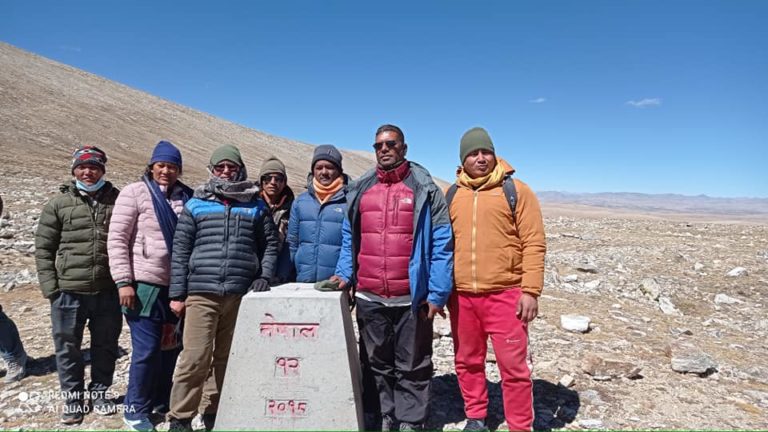
The government-commissioned report aimed to document and highlighted the specific areas of concern along the border and sheds light on the situation for further action and resolution of the border dispute.
Talking to Khabarhub, Shahi emphasized the urgent need for resolving the border disputes, condemning China for encroaching upon Nepal’s territory.
He underscored the importance of prompt resolution to address the territorial issues between the two countries.
Meanwhile, the recent report prepared by the government’s Committee also underscored the need for urgent dialogue with China to address the situation.
Regrettably, the Nepal government has not demonstrated any willingness to implement the recommendations put forth in the report.
“The indifference exhibited by the Nepal government is truly disheartening,” Sedhain expressed, reiterating his previous statement.
He further commented, “Both the Department of Survey and the government as a whole appear to show minimal concern in addressing this pressing issue.”
Sedhain pointed out that the government has failed to establish a dedicated team for conducting negotiations with the Chinese side concerning the issue.
The Committee members conducted an extensive study of the border area and border pillars from August 19 to 25, 2020, spanning Limi Lapcha to Hilsa.
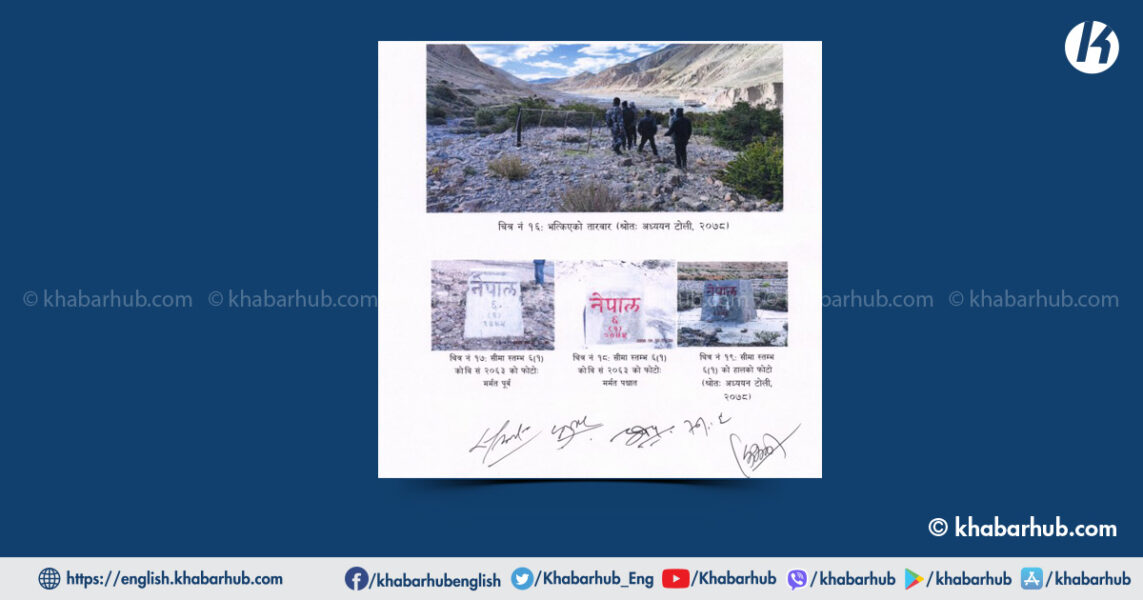
After completing their thorough study, they submitted a detailed report to the Ministry of Home Affairs. In the comprehensive 58-page report prepared by the Acharya Committee, it is documented that barbed wire has been installed by China, extending towards Nepali territory in Humla. This installation has resulted in difficulties for livestock grazing in the affected areas (Page 36).
Furthermore, the report states that China was making efforts to assert control over the source of Nepal’s Kholsi River, which flows toward Tibet. The Committee submitted the study report to the then Home Minister, Bal Krishna Khand.
The report also highlights that China has created an obstruction at the border crossing near Border Pillar 3.
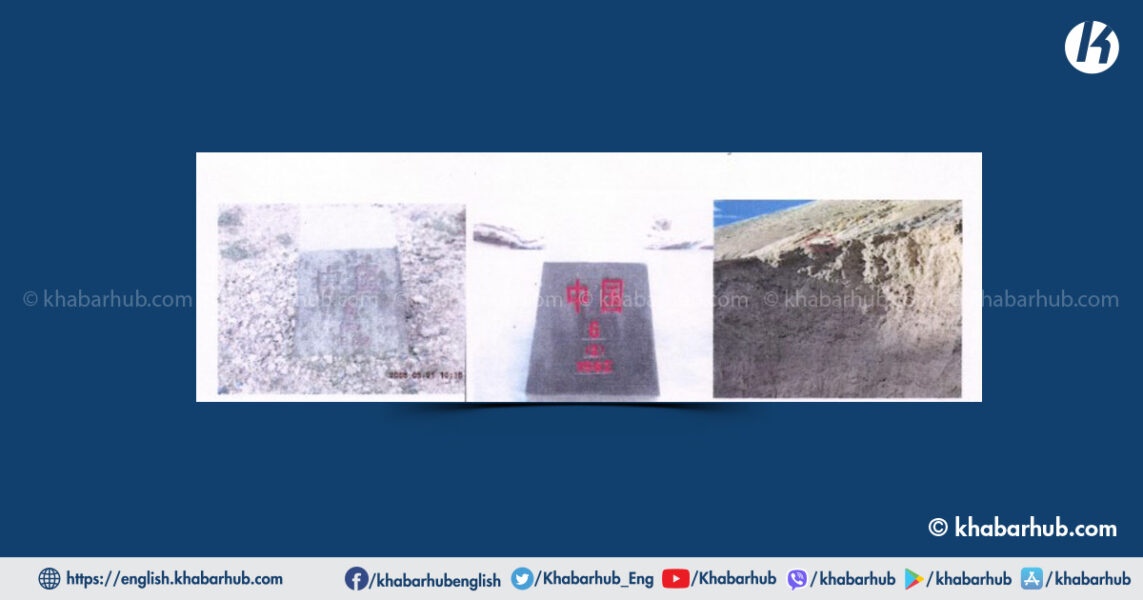
According to the report (Page 18), during the discussion among local residents and representatives from different political parties in Humla district, it was concluded that there are no issues of any kind concerning border pillar No. 4 along the Nepal-China border and the Armed Police Force Nepal.
It has been confirmed that the border pillar is correctly positioned and in good condition (as seen in picture no. 6), the report stated. However, there have been occasional instances where the Chinese side has been observed to impede movement in the area.
Additionally, the report includes photographic evidence that reveals China’s construction of a permanent canal and water tank to divert water from Kitkhola to China, originating from boundary pillar 5 (2) in Hilsa, situated 145 meters south of Nepal.
Border Pillar No. 5 (1) and 5 (2): According to the original document concerning the Nepal-China border, it states that starting from boundary pillar No. 4 and extending eastward along the boundary line, it descends from the tributary of Kit Hill.
Additionally, from boundary pillar No. 5 (2) situated on the west bank of the Yada River, it follows the midstream of the Yadangre River between the two border pillars of Gujri No. 5. Based on this information, it appears that there are five (2) border pillars located along the Nepal-China borderline.
However, upon the arrival of the study team, the canal was found to be covered.
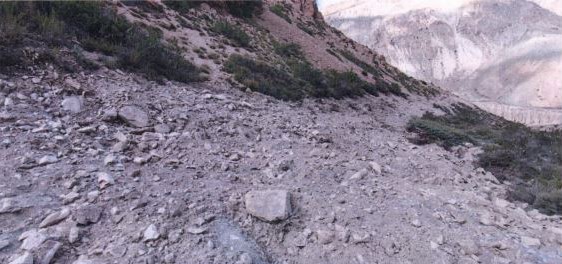
Furthermore, the report confirms that a CCTV camera was installed on Nepali land, a 300-meter-long wire fence was erected on Nepali territory, and it was positioned further north than border number 6(1).
The report further highlights that a fence has been erected from border post No. 5 (2) to border post No. 6 (1). The Committee strongly recommended its immediate removal.
According to recommendation Number 3 in the report, the entire wire fence situated in the west-south territory from border post No. 5(2), extending from the Kit River to border post No. 6(1) and up to the Karnali river on the north side, which belongs to Nepal, should be promptly dismantled.
The committee’s recommendation emphasizes the restoration of Nepalese sovereignty and territorial integrity in that area.
However, due to flooding in the Yadangre River, the fence has been partially damaged. The report emphasizes that China’s actions indicate an attempt to establish a presence within Nepali territory.
According to the report, Border Pillar 7(2) at Hilsa is missing.
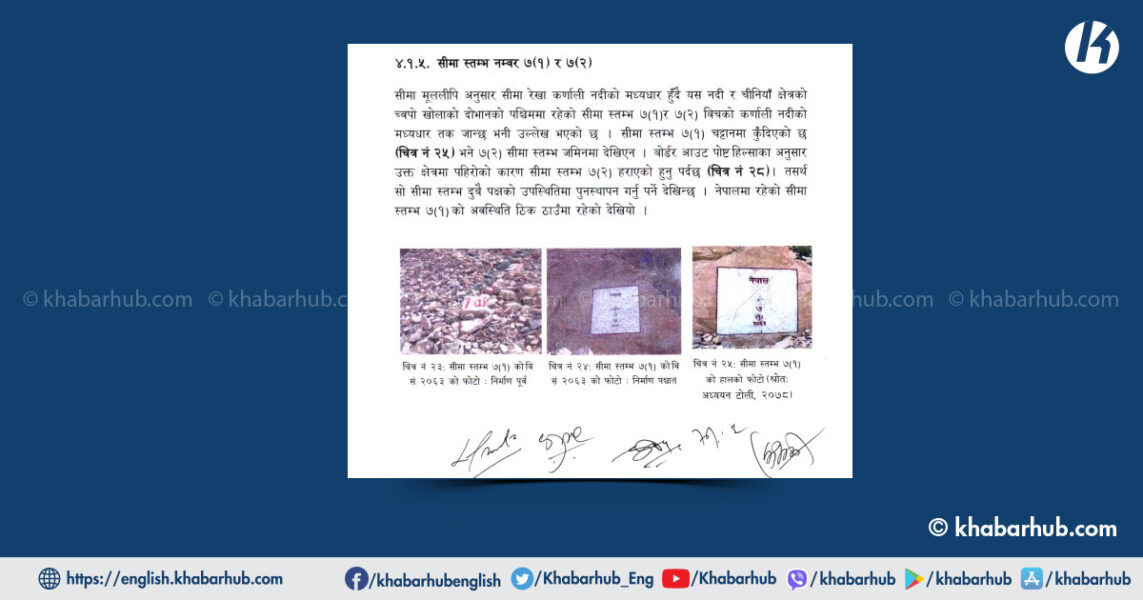
Arun Kumar Subedi, a foreign affairs expert, had earlier stated that the issue cropped up due to a lack of GPS coordinates along the border with China.
Nepal’s agreeing with China on border issues led to complexities, and China has been showing a monopolistic and arbitrary attitude toward Nepal.
“The problem is that there has been a nationalist narrative in Nepal that is in favor of China,” Subedi added, warning that Nepal could lose several strategic points along the border with China if Nepal did not speak up.”
The report reveals that an iron bar fence has been constructed starting from the middle of border pillar 9(2) and extending 32 meters towards pillar 10.
According to the report, it is stated that structures should not be built within 10 meters on either side of the border. However, it has been observed that the Chinese side unilaterally repaired border pillar number 12 in Thasjri Lapche Bhanjyang.
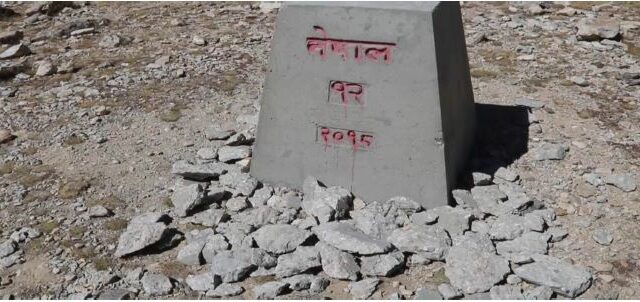
As per Article 23 of the Nepal-China Border Code, the responsibility of repairing the border pillar lies with Nepal. Unfortunately, no fieldwork or collaborative efforts between the two countries have taken place for an extended period of time.
It is noteworthy that this particular region serves as the primary route to Mansarovar, a revered pilgrimage site for Hindus. The government committee emphasized that the Chinese side has created obstacles that impede visits to Mansarovar, causing hindrances for pilgrims.
The Committee’s report also suggests that efforts should be made to facilitate the easy access of Nepali people to the Mansarovar darshan (pilgrimage) site, located on the Nepalese border in Lolung Bhanjyang.
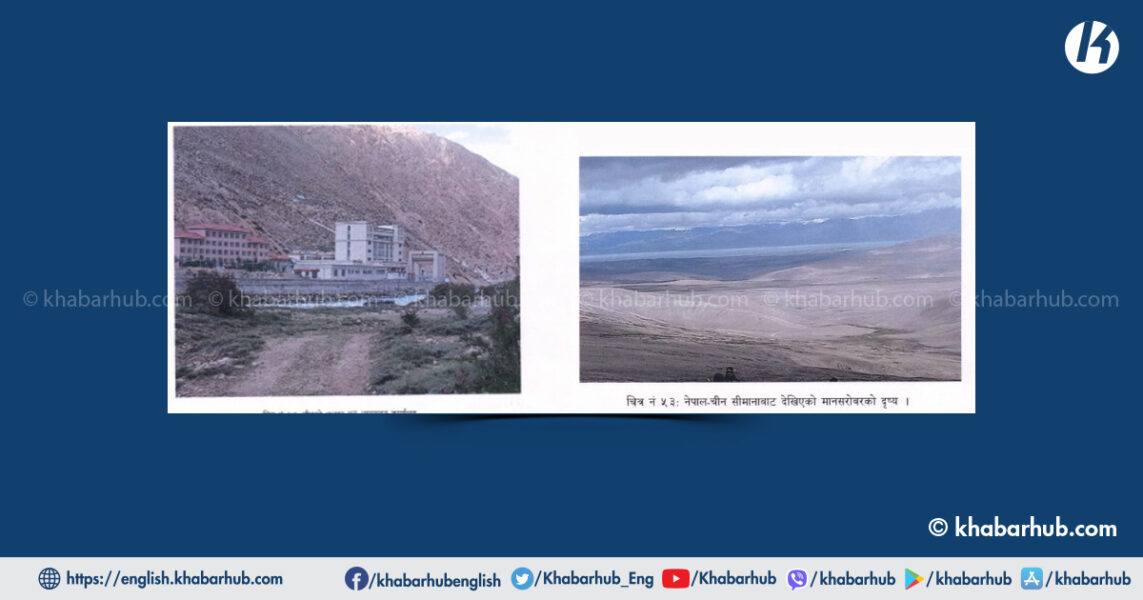
The report recommends initiating a diplomatic initiative to ensure smooth movement and proposes constructing a tourist structure at that location to provide necessary facilities for the pilgrims.
These measures aim to enhance the pilgrimage experience and ensure convenient access for Nepali pilgrims visiting Mansarovar.
The Committee has stated that it is not feasible to have Kailash Mansarovar darshan (pilgrimage) in the border area near the Uchha Takura on Nepal-China border pillar number 12.
The Committee’s report highlights that due to prevailing circumstances, pilgrims are compelled to worship Kailash from the Nepalese territory, under the supervision of Chinese security forces.
This action reflects reality and acknowledges the need to ensure the safety of the pilgrims while taking into account the security considerations in the area.
The Committee’s recommendations have explicitly highlighted that the Chinese side is obstructing Nepalese access to the border area.
Nepali Congress leader Rangamati Shahi, who represents Humla district, firmly upholds the principle that Nepal must not compromise on its sovereignty.
Expressing her viewpoint, she stressed the pressing need for resolving the border dispute that has emerged since the year 2021 BS (1964 AD).
In light of this issue, the Committee report has also proposed the convening of a mechanism meeting to address and resolve the problem.
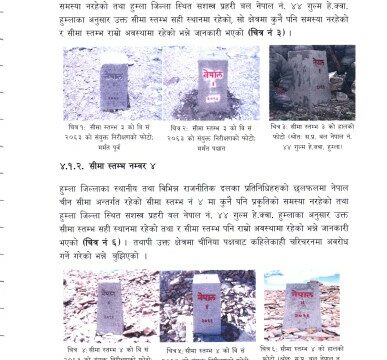
Currently, there are three mechanisms established for dealing with border issues between Nepal and China: the Joint Inspection Committee at the level of foreign secretary level, the Joint Expert Group at the level of the Director General of the Survey Department, and the Joint Inspection Team at the level of senior surveying officer.
However, it is worth noting that none of these teams are currently active or operational.
It should be noted that a border agreement was indeed signed between Nepal and China on March 22, 1960 (Page 8 in the report). The agreement was signed by the then Prime Minister of Nepal, BP Koirala, and Chinese Prime Minister Zhou Enlai.
This agreement laid the foundation for the Nepal-China Border Treaty, which was subsequently signed on October 5, 1961. Additionally, on January 20, 1963, the original Boundary Protocol was signed by Nepal’s then Foreign Minister Tulsi Giri and Chinese Minister Wen Yi.
These significant agreements and protocols played a crucial role in defining the border between Nepal and China.
Former Ambassador Vijay Kant Karna emphasized that Nepal has not effectively engaged in discussing various issues and problems with China.
Karna’s statement suggests that there is a need for improved dialogue and communication between Nepal and China to address and resolve bilateral concerns.
According to Karna, Nepal has been unsuccessful in establishing a joint monitoring team to assess the condition of the border pillars and highlighted the importance of promptly resolving this issue, indicating the need for a collaborative approach in order to effectively address and monitor the situation along the border.
Karna said that the government should immediately hand over the report to the Chinese side. “Any form of encroachment is unacceptable,” he noted.
The Nepali Congress (NC) in October 2020 in the capacity of an opposition party, had demanded that the government sent a protest note regarding the Chinese encroachment in Nepal’s territory in Humla.
Issuing a press release, NC had also come down heavily on the government over its silence on the intrusion of Nepali territory in Humla.
Meanwhile, here’s what political analyst Saroj Mishra has to say: “There is a prevailing belief in Nepal that criticizing China is deemed ‘anti-national,’ while speaking against India or the US is considered ‘patriotic’ by default. Mishra asserts that Nepal requires a visionary leader who possesses the courage to challenge the current narrative and speak the truth.”
First Joint Inspection (1979)
In May 1977, the inaugural Nepal-China Border Joint Inspection Committee (Joint Inspection Committee) was established, according to the report (Page 9).
Two years later, in 1979, the committee successfully concluded its first joint inspection, resulting in the signing of the Boundary Protocol for the second time.
“This significant agreement was prepared by representatives from both Nepal and China,” the report said.
During that period, an extensive effort was made to prepare a comprehensive border map covering the entire border region, comprising a total of 57 sheets.
However, due to certain challenges, three boundary pillars (33, 37, and 38) remained unconstructed at that time. Additionally, the exact locations of boundary pillars 57 and 62 could not be determined or located during the mapping process, according to the report.
Second Joint Inspection (1989)
The report said that following the agreed-upon schedule of conducting a joint border inspection every 10 years, the second Nepal-China Border Joint Inspection Committee was established (Page 14).
The second inspection took place in 1989 (2045 BS). During this period, significant progress was made in terms of constructing the boundary pillars that remained incomplete during the first joint inspection.
Specifically, border pillar No. 33 was successfully constructed; however, border pillars 37 and 38 were still pending construction and remained incomplete.
Third Joint Inspection (2006)
In May 2005 (2062 Baisakh), the third Nepal-China Border Joint Inspection Committee (JIC) was formed, along with the establishment of the Joint Expert Group (JEG) and five Joint Inspection Teams (JIT) for fieldwork.
The joint border inspection officially commenced in April 2006, and the fieldwork was successfully completed.
A noteworthy accomplishment during this inspection was the use of GPS technology to survey and locate all border pillars along the Nepal-China border.
Furthermore, significant progress was made in terms of technological advancements and data management.
The Geographic Information System (GIS) of the Nepal-China Boundary was developed, and certain border maps were updated during this inspection.
In addition to these achievements, special boundary pillars were constructed on both sides of the Kodari Miteri Bridge.
Moreover, Auxiliary Boundary Markers (54/1) 1 and (54/1) 2 were installed at two specific locations. Notably, during this inspection, previously undiscovered boundary pillars 57 and 62 were successfully located, the report added.
The report on Page 36 has given the following suggestions:
In situations where problems arise on the border or other issues occur, the two countries have established a practice of collaboratively resolving disputes through the utilization of Joint Inspection Teams, Joint Expert Groups, and Joint Inspection Committees. The activation of these mechanisms becomes essential under such circumstances.
Efforts should be made to undertake diplomatic initiatives aimed at facilitating the movement of Nepalese pilgrims to the Mansarovar darshan (pilgrimage) site, which is situated on the Nepalese border in Lolung Bhanjyang.
It would be appropriate to consider constructing a dedicated tourist structure at that location and providing essential facilities for the convenience of the pilgrims visiting the site.
Immediate action should be taken to remove the entire barbed wire fence in the west-south area from the Kit River to the border pillar No. 6 (1) on the north side, as this region belongs to Nepal’s territory.
It is essential to address this issue promptly and ensure the removal of the fence in order to uphold the territorial integrity and sovereignty of Nepal.
Since the Chinese side has built a fence and a permanent structure above border pillar No. 9 (2), a 10-meter open area should be maintained according to the protocol.
In accordance with the established protocol, it is imperative to maintain a 10-meter open area above border pillar No. 9 (2) where the Chinese side has constructed a fence and a permanent structure. It is essential to address this matter and ensure that the designated open area is maintained as per the protocol.
As the border pillar No. 7 (2) of the Chinese territory remains unidentifiable, it is necessary to initiate a joint effort by the border groups to search for and relocate the pillar to its original position in accordance with the established protocol.
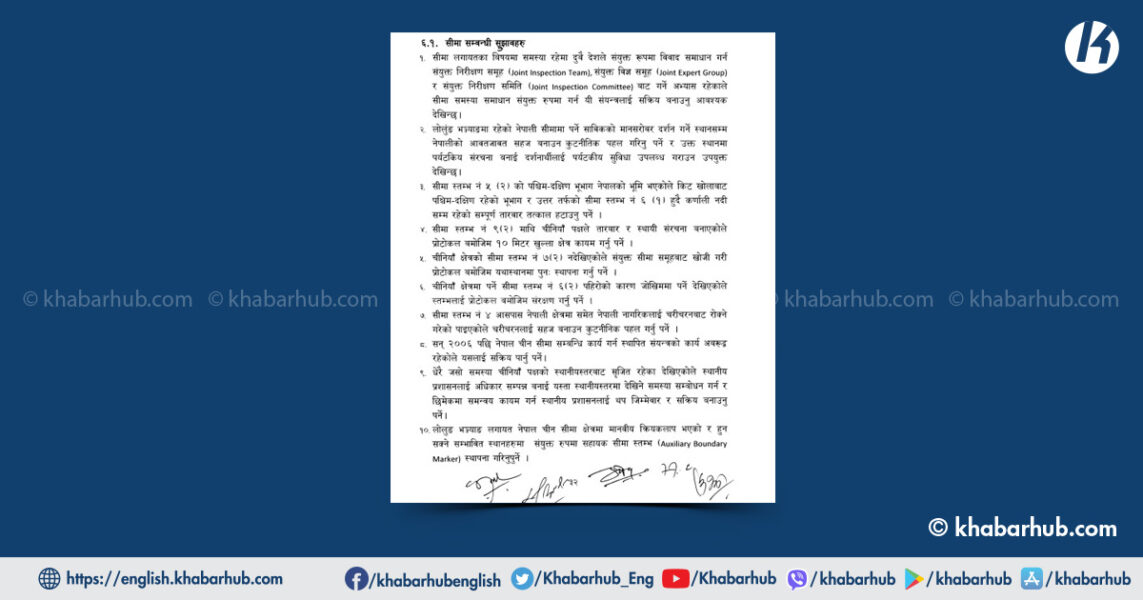
Considering that border pillar No. 6 (2) in Chinese territory is currently exposed to the risk of landslides, it is imperative to take necessary measures to protect the pillar in accordance with the established protocol.
Since it has been found that Nepali citizens are being prevented from grazing their cattle even in the Nepali area around the border pillar no. 4, diplomatic initiatives should be taken to facilitate cattle grazing.
In light of the prevention of Nepali citizens from engaging in cattle grazing even in the Nepali area surrounding border pillar no. 4, it is crucial to undertake diplomatic initiatives aimed at facilitating this traditional practice.
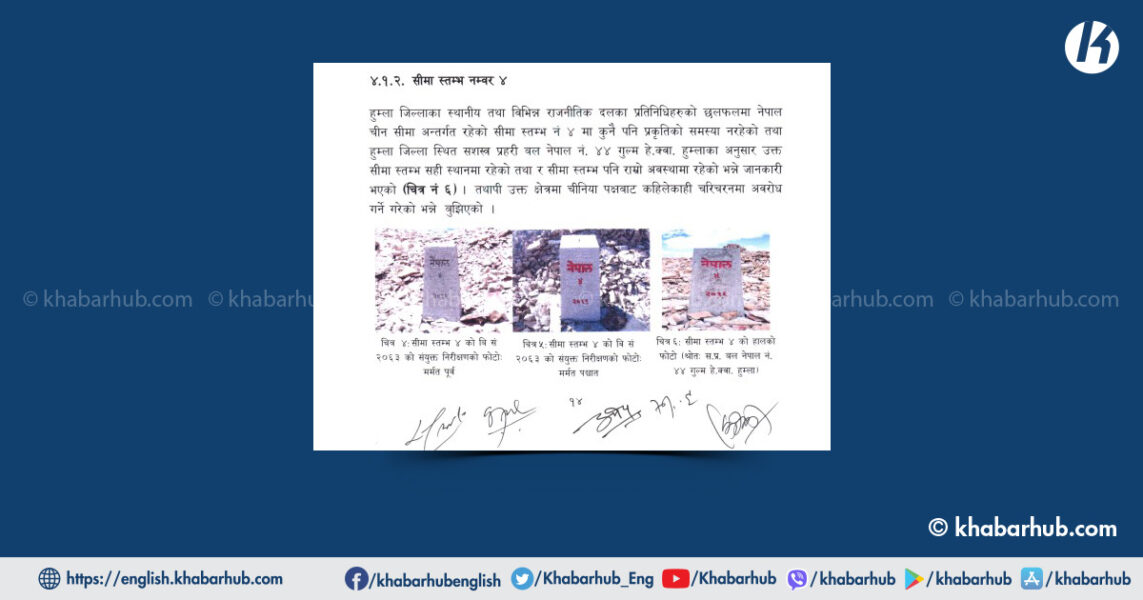
Since 2006, the operational effectiveness of the mechanism established to manage the Nepal-China border has been hindered, resulting in a lack of progress. Therefore, it is imperative to take immediate action to reactivate and revitalize this mechanism.
Since it seems that most of the problems are created by the Chinese side at the local level, the local administration should be empowered and made more responsible and active to address such problems at the local level and to maintain coordination in the neighborhood.
Recognizing that a significant portion of the issues arise from the Chinese side at the local level, it is important to empower and enhance the responsibilities of the local administration to take a more proactive and effective role in addressing problems that occur at the local level.
It is essential to establish Auxiliary Boundary Markers jointly in areas along the Nepal-China border, such as Lolung Bhanjyang, where humanitarian activities have taken place or are expected to occur.
Also Read:


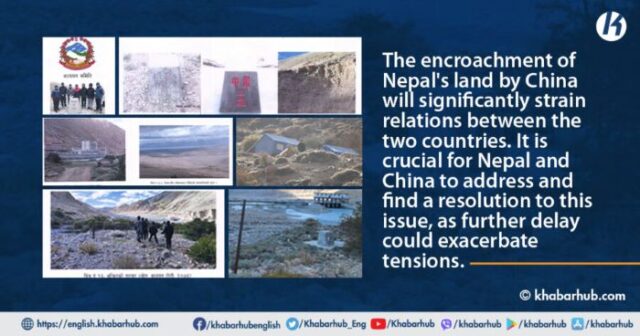


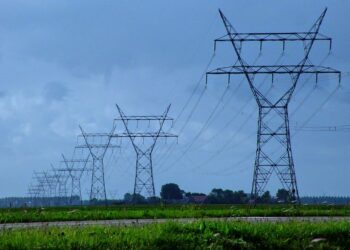



Comment